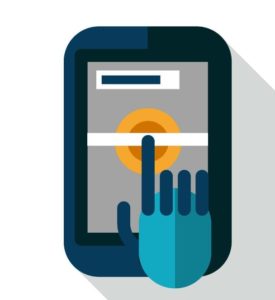The invisibility of behavioral biometrics is a massive factor in the modality’s recent rise in popularity. Not only did it rank high in our 14th Annual FindBiometrics Year in Review, but the latest research from Acuity Market Intelligence on the topic has behavioral biometrics slated to become mainstream by the end of this year. The fact is, behavioral biometrics have two major advantages: as we explored last week, they can be used to address malware threats in addition to providing passive authentication; and as we will explore this week, behavioral software offers an incredible level of user convenience.
The proposition of biometric authentication in general has always been greater security and greater convenience. The latter part of that dual promise is elegantly realized with modern behavioral biometrics technology, and it stems from the fact that rather than being one single measurement of a biological trait, behavioral security is built up of hundreds of micro-factors. To illustrate how this collage of factors leads to frictionless and intuitive identity tech, as part of Behavioral Biometrics Month we are going to look at just a few of the modalities within modalities that make up one of today’s most prominent security technologies on the rise.
Just Your Type
 Keystroke biometrics measure the natural rhythms a user has internalized through their constant use of one of the most classic interface tools. When filling out an online form, entering text into a dialogue box, behavioral biometrics run in the background measuring your typing metrics and comparing them to those associated with your behavioral profile. As pressure sensitive keyboards become more common, the way you strike a key in comparison to another—maybe you lean on your left shift key a tiny bit more than your right—will become as distinct as that annoying s/d typo habit you just can’t seem to shake.
Keystroke biometrics measure the natural rhythms a user has internalized through their constant use of one of the most classic interface tools. When filling out an online form, entering text into a dialogue box, behavioral biometrics run in the background measuring your typing metrics and comparing them to those associated with your behavioral profile. As pressure sensitive keyboards become more common, the way you strike a key in comparison to another—maybe you lean on your left shift key a tiny bit more than your right—will become as distinct as that annoying s/d typo habit you just can’t seem to shake.
Walk With Me
 Your mobile device has a gyroscope in it. The same sensor that shifts your smartphone screen from profile to landscape view when you’re taking a picture can also be used to track the physical motions that are unique to your body. Do you keep your phone in your front pocket, back pocket, or in your bag? Are your legs long or short? Do your shoes have heels or are they flats? All of these quotidian aspects of your daily life can add up to creating a unique motion profile leveraged by behavioral software to understand how your device moves when you carry it. If behavioral biometrics are on duty after your phone has been stolen, it will know you aren’t the one carrying it even before the thief tries to access your valuable accounts.
Your mobile device has a gyroscope in it. The same sensor that shifts your smartphone screen from profile to landscape view when you’re taking a picture can also be used to track the physical motions that are unique to your body. Do you keep your phone in your front pocket, back pocket, or in your bag? Are your legs long or short? Do your shoes have heels or are they flats? All of these quotidian aspects of your daily life can add up to creating a unique motion profile leveraged by behavioral software to understand how your device moves when you carry it. If behavioral biometrics are on duty after your phone has been stolen, it will know you aren’t the one carrying it even before the thief tries to access your valuable accounts.
Hold Me Tight
 Similar to how you walk with your phone, the way you hold it is also unique. Right or left handedness can be measured, as can the press size of your touchscreen interactions. Everyone holds a phone slightly differently, and the metrics collected by behavioral software pertaining to how a device is handled can offer some surprisingly detailed measurements. Some behavioral biometrics can derive the length of your arm this way, and even detect telltale tremors in your hand.
Similar to how you walk with your phone, the way you hold it is also unique. Right or left handedness can be measured, as can the press size of your touchscreen interactions. Everyone holds a phone slightly differently, and the metrics collected by behavioral software pertaining to how a device is handled can offer some surprisingly detailed measurements. Some behavioral biometrics can derive the length of your arm this way, and even detect telltale tremors in your hand.
The Way We Touch
 Consider how you interact with your touchscreen. Do you operate your device one-handed, cradling it in your palm and letting your thumb swipe, press and type? Or do you prefer the pin-point accuracy of your opposite hand’s index finger? Some people use styluses to navigate their mobile life, and others still prefer to text using two thumbs. Behavioral biometrics learn your user interface preferences, so that a thumb-typer won’t be able to pass for a swipe-typist.
Consider how you interact with your touchscreen. Do you operate your device one-handed, cradling it in your palm and letting your thumb swipe, press and type? Or do you prefer the pin-point accuracy of your opposite hand’s index finger? Some people use styluses to navigate their mobile life, and others still prefer to text using two thumbs. Behavioral biometrics learn your user interface preferences, so that a thumb-typer won’t be able to pass for a swipe-typist.
The Bigger Context
 Let’s get philosophical for a second. Where is the border of an organism’s biological identity? You could easily argue that it ends at the skin, that we are all unique individuals encapsulated in a membrane, and that’s it. But it has long been accepted than animals have an extended phenotype—that our genetic code not only dictates how our bodies are built (fingerprints and all), but also extends to our environments. Beavers make dams, birds make nests, spiders make webs, and humans build cities, infrastructure, home offices, banks, farms and more. How we interact with our environment is part of who we are, and if you’re a biological determinist, there’s not much difference between your fingerprint and where and when you choose to do your online banking.
Let’s get philosophical for a second. Where is the border of an organism’s biological identity? You could easily argue that it ends at the skin, that we are all unique individuals encapsulated in a membrane, and that’s it. But it has long been accepted than animals have an extended phenotype—that our genetic code not only dictates how our bodies are built (fingerprints and all), but also extends to our environments. Beavers make dams, birds make nests, spiders make webs, and humans build cities, infrastructure, home offices, banks, farms and more. How we interact with our environment is part of who we are, and if you’re a biological determinist, there’s not much difference between your fingerprint and where and when you choose to do your online banking.
Contextual identity—your location, your device, etc.— is a major factor in behavioral biometrics solutions, even though it is traditionally considered a different branch of the larger ID picture. That said, as behavioral biometrics continue to gain traction in vertical markets, finding themselves integrated into more and more solutions, they may one day change our thinking about where we draw that border between ‘what we we are’ and ‘what we do.’ That’s the power of behavioral biometrics, after all—the technology that authenticates you simply for being yourself.
*
Behavioral Biometrics Month is made possible by our sponsors: BioCatch and NuData Security.
Stay posted to FindBiometrics throughout April as we continue to bring you featured coverage on the topic of behavioral biometrics. Register for our upcoming webinar on the topic, Continuous Identity: Why Behavioral Biometrics Are Going Mainstream. Be sure to follow us on Twitter so you don’t miss a thing.
—
April 20, 2017 – by Peter B. Counter



Follow Us